Your RV tank sensors are a straightforward way to know when to empty your tanks. However, many people don’t even realize they need to keep these sensors clean. Even if you do, you might not know how to do the job. Fortunately, it’s easier than you might think, and regular maintenance will keep your RV tank sensors working better for longer.
What Are RV Tank Sensors?
RV tank sensors let you know how full your holding tanks are. You most likely have sensors for both your grey and black water tanks. These sensors let you know when you need to empty your tanks. If they don’t work correctly, it’s anyone’s guess when they’re full. And overflowing tanks are not something you want to deal with, ever!
In addition to your grey and black tank sensors, you’ll likely have a sensor for your fresh water tank. Considering this tank only holds clean drinking water, you won’t need to clean this tank’s sensors. However, it is a good idea to regularly sanitize your fresh water tank to keep your drinking water safe.
Click here to see our step-by-step tutorial on how to sanitize your RV’s fresh water system!
How Do RV Tank Sensors Work?
RV tank sensors usually give you five different readings. You can expect to know when the tank is empty, ¼, ½, ¾, or full on most RVs. Each one of these sensors is in, or on, the tank’s sidewall. The ¼ full sensor is found closest to the tank’s bottom while the full sensor is at the top.
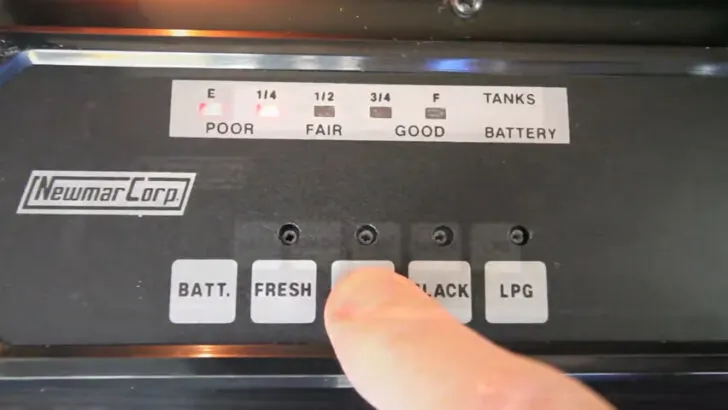
RV tank sensors offer important information about how full your tanks are.
When your tank reaches a particular level, that sensor is activated. This turns on your monitoring panel’s indicator light. You’ll know how much room is left in your tanks and when you should dump them by paying attention to these lights.
Common RV Holding Tank Sensor Problem
It’s common for your RV tank sensors not to read correctly. This can happen for several reasons, but the most common reason for incorrect readings is a dirty tank. The material, including waste, grease, food particles, and toilet paper can get caught on the sensors (if they are through-wall sensors that actually penetrate into the tank) or on the tank walls (which blocks sensors mounted on the outside of the tank). When this happens, the tank will read fuller than it is.
If you dump your tanks and the sensors say they are still partway full, a deep clean is in order. Luckily this sensor problem is an easy fix (most of the time).
Options for Cleaning Your RV Holding Tank Sensors
Tank sensors stop working when gunk builds up on, or over, the sensor. The solution to this problem is to clean the tanks. There are a few ways to go about this. Below we’ll show you four options for cleaning your RV tank sensors. Give each one a try to see what does the trick for you.
Use a Tank Cleaning Wand
There are commercial products available specifically for cleaning your RV tanks. Usually, a tank cleaning wand is for your black water tank. The wand sprays high-pressure water in a circular motion to clean the sidewalls of your tanks. Here’s one example of a simple RV tank cleaning wand:
- Package Dimensions: 27 L x 2 H x 3.75 W (inches).Fit Type: Universal Fit
- Package Weight: 0.5 pounds
Cleaning your RV tank sensors with a cleaning wand is quite simple. The first step is to dump your tanks. Next, hook the wand up to a fresh water source using a hose. (Do not use your drinking water hose for this for obvious reasons)! Once you have the hose connected, bring the wand inside your RV to your bathroom.
Next, press down the flush lever on your RV toilet. Keeping the lever pressed down, insert the cleaning wand into the tank. Start at the bottom and work your way up, with the cleaning wand continually running. Remember to wear gloves to prevent the spread of disease and general yuckiness!
If you haven’t cleaned your tanks in a long time, you may need to fill them, dump them, and repeat to make sure all the water coming out is clean. Using a clear sewer elbow is important for knowing when the water runs clear.
Soak Your Tank with Dishwasher Detergent
This method of tank cleaning works well with both black and gray water tanks. Before your next road trip, add about a cup of dishwasher detergent, like Cascade. The sensors impacted will determine how full to fill your tanks, but we don’t recommend much more than halfway full.
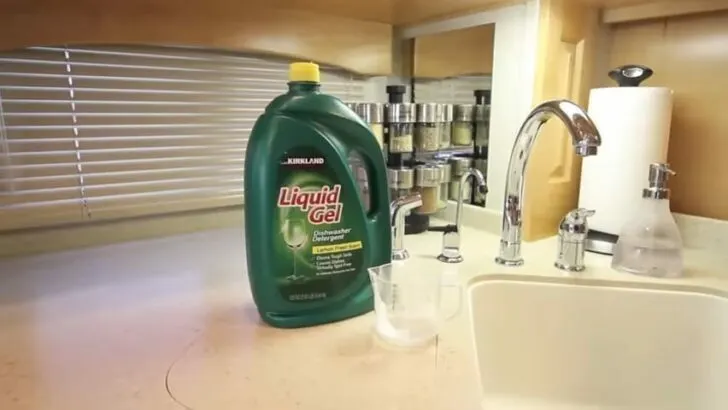
Dishwasher detergent is an effective cleaning agent for your black and gray tanks.
You want to be sure that you’re using a detergent designed to be used in an automatic dishwasher. There are two reasons for this. First, dishwasher detergent won’t foam up. You don’t want to use a soap/detergent that is going to get sudsy, as it will likely foam up in your tank during the next step. The second reason is that dishwasher detergent contains very effective softening agents. These will help to break down grease and oils… and get other residue softened so it comes loose from the sensors and tank sidewalls.
After that, simply drive to your next destination. The drive’s motion will agitate the detergent mixture to clean off your gunked-up sensors. We recommend using this method when you are en route to a camping destination with full hookups. That way you can empty your tanks as soon as you arrive.
This is a great method to try if your sensors didn’t get sufficiently clean using the cleaning wand method. The soap swishing around in your tanks will give them a good scrubbing while simultaneously soaking & softening any buildup.
Use an Enzymatic Tank Cleaner
A third option for cleaning your RV tank sensors is to use an enzymatic tank cleaner. These cleaners do the heavy lifting when you’re dealing with substantial waste. The cleaner breaks down waste into smaller pieces. Then when you dump your tanks, these smaller pieces flush out to prevent clogs and sensor issues.
A nice bonus of an enzymatic cleaner is that it works quickly. And these cleaners often contain a deodorant as well, which helps eliminate stinky tanks. Regularly using an enzymatic tank cleaner is a straightforward way to prevent tank buildup from occurring in the first place. Simply add to the tank after each dump. For extremely gunked-up tanks, you may need something even more powerful, like Happy Campers Extreme (not available to be shipped to California).
- Super cleans RV holding tanks
- Sensors: Restore poor working sensors
Another good option (which CAN be shipped to California) is Unique’s Clean-It:
- New and improved formula! Using Clean-It is like power-washing your black tank. Works in 48-72 hours, no driving required. Cleans more effectively...
- We took Unique Tank Cleaner, the strongest RV black tank cleaner on the market, and made it even stronger! Clean-It is powered by billions of enzymes...
Have Your RV Holding Tanks Power Cleaned
The last and final option for cleaning clogged tank sensors is to have your tanks power washed. If the above options can’t get your sensors working again, this is the choice for you. It’s kind of like a colonic for your RV. A technician will come to your RV (you’ll need to be at a full hook-up RV park with easy access to a sewer connection) and will use a specially designed pressure washer that can be inserted up through your tanks’ dump valves. The high-pressure water will power clean the inside walls of your tanks, blasting away any gunk/residue that has built up.
One of the things that can be blocking your tank’s sensors, even the non-penetrating kind that sense tank levels right through the tank walls, is a mineral called “struvite” which is a mineral crystal composed of magnesium, ammonia and phosphate that forms in wastewater. As it builds up, it can block your tank’s sensors, causing false/inaccurate readings.
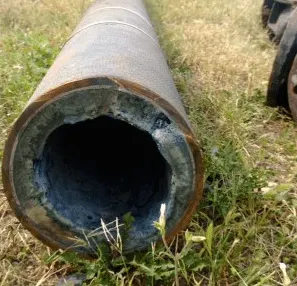
Waste water treatment plant pipe clogged with struvite.
It’s not just RV holding tanks that can become clogged with struvite. Waste water treatment plants struggle with it, too. And for them, it can be even more of a problem, accumulating on the inside of pipes and restricting the flow.
Because struvite adheres very firmly to the walls of your tank (like a barnacle attached to a piling), the most effective solution is to have it physically removed. Luckily, high-pressure water can do it.
Our tank sensors were giving us trouble and not reading correctly, no matter what we tried. So we had our tanks professionally cleaned. You can watch the video here:
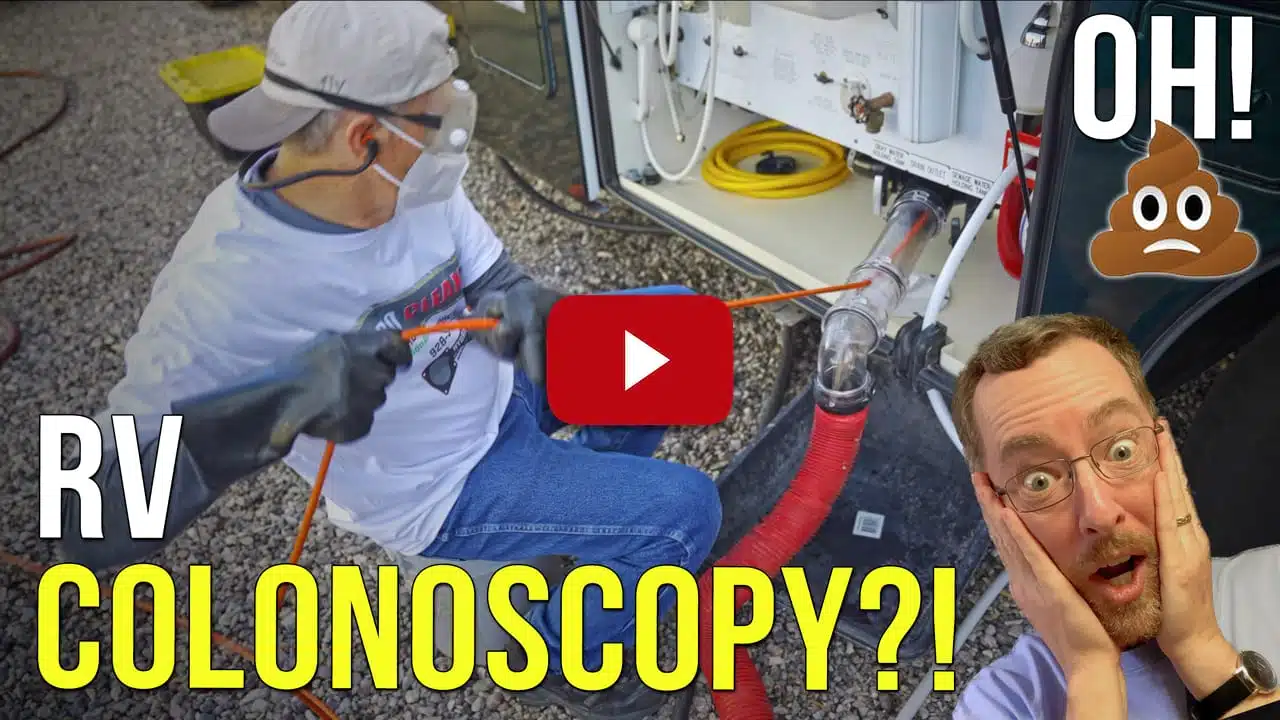
Watch our video about having our RV holding tanks pressure washed by HYDRO CLEAN in Lake Havasu City, AZ.
We’re happy to report that, after this tank cleaning, our sensors are back to reading normally! For us, this is a big help since we spend a great deal of time boondocking. Knowing when our tanks are close to being full is important.
How to Prevent Gunked-Up Sensors
Once you get your RV tanks clean, you’ll want to do everything you can to keep them that way. This will prevent you from having additional RV tank sensor problems in the future. There are a few things you can do to prevent issues:
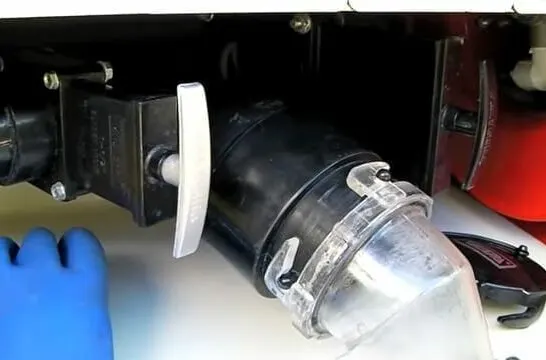
Important tip: Always keep your black tank valve CLOSED unless you’re dumping the tank!
One is to flush your tanks with plenty of water. You’ll also want to make sure you keep your RV black water tank closed unless you’re dumping the tank’s contents. As mentioned previously, regular use of an enzymatic cleaner can also help prevent buildup. Adding a cleaner after each dump is an excellent way to stay on top of things.
How you use your RV toilet is also important. You need to use toilet paper that’s going to break down quickly. Not all toilet papers do. Some are sold as “RV Safe”, but don’t waste your money on these often-inferior brands.
You can test your favorite brand of toilet tissue to see if it will work. Once you’ve identified a safe toilet paper you’ll be happy using, just be sure to keep the quantity of it down. Even toilet paper that breaks down easily can be a problem if you flush large wads of it down the toilet.
To prevent gunked-up sensors in your kitchen’s gray tank, it’s essential to keep food and grease from going down the drain. Adding a food trap will keep food out of your tanks, and tossing grease in the trash before cleaning the pan will help prevent buildup. Additionally, don’t hesitate to use an enzymatic cleaner in your gray tank.
Conclusion
We understand how frustrating it is when your RV tank sensors don’t work. Fortunately, there are several options for breaking down buildup and keeping the sensors clean. A consistent cleaning regimen and regular maintenance will go a long way! If your sensors aren’t working, give these tips a try. Soon, there will be no more guessing if your tanks are full!
Geek Out with Us Every Week
Join our newsletter to learn about all things RV-related. Every week we offer free tips, tricks, product reviews, and more to our online community of RVers. Whether this is your first time on the road or you’re a seasoned expert, we’d love for you to geek out with us!





Tom T.
Saturday 19th of August 2023
We used a company, Kleen Tank to clean our tankS while we attended the KZ Rally recently in Shipshewna, IN. The private-party seller (we are 2nd owners) of our Durango Gold 5W had used "flushable' wipes and possibly baby wipes down the commode. That made Kleen Tanks' job more challenging. Wendy, from Missouri and her team (Chrissy & Mark from Al) did an impressive job with the tanks while being very courteous, informative, and respectful of our 5W RV knowledge (we had many questions). Kleen Tank provided us a "start over" with our tanks!
Jay Krumm
Tuesday 30th of May 2023
Thank you for the advice but what do I do when my 5 Wheel stays in the camp ground? The sensors hardly work. I have a Jayco Pinnacle 2012 reqs 36.
TheRVgeeks
Tuesday 30th of May 2023
Hi Jay... driving the RV to agitate what's in the tank helps, but isn't 100% required. You can try doing the soak (leave it longer before dumping if you can) on the tank without driving it (since you're stationary) and it should still help. Won't be AS effective as doing the drive, but it may be enough to get your sensors working again.
Midnigh
Saturday 12th of February 2022
The Happy Camper Extreme cleaner is pure TSP, trisodium phosphate. This product is very harmful to humans and extremely harmful to the environment. When washed into water sources (lakes, rivers, ocean) it causes horrible algae blooms that choke out other natural inhabitants. Best to find another alternative!
Friz
Monday 22nd of February 2021
The Amazon product advertised is "currently unavailable". Did I skip the section on physically removing the sensors and cleaning or replacing? Cleaners, spraying etc. are good to clean the tank walls. Removing the sensors addresses the problem directly. I am going to approach this 1st using the splash and spray methods followed by sensor removal, cleaning or replacement.
TheRVgeeks
Monday 22nd of February 2021
Hey Friz. Sorry about that... looks like Amazon sold out of the Happy Campers Extreme. If it doesn't come back in stock, you could try using NoFlex Waste Digestor (also available on Amazon: https://amzn.to/3sfvjIG) instead. We've used it ourselves and it seems to work (instructions are for marine use as a regular treatment, but we just dissolved a couple of scoops in water and put it in the tank). You also didn't skip "the section on physically removing the sensors"... we didn't include it in this post as we figured most people wouldn't go to that length (plus lots of other people have sensors mounted on the outside of the tank, so removing them won't do any good to remove sludge).
We hope the internal cleaning works for you so you don't have to end up taking the sensors out!
John S.
Wednesday 17th of February 2021
Very good video on pressure-washing the tanks. When we were at the Newmar rally in New York I saw a fellow doing that and attended his impressive seminar. We got our tanks done the next day.
Our tanks did not have as much struvite as yours but we are members of the 10% group that did NOT recover the level indicators to normal use. You did not say if your level indicators returned to normal - did they? Also, I believe his comments about your tanks being 'not too bad'. You, like everybody else, drained the tanks and had clear water running before the powerwash. The video only showed a minute or two of debris, which is very little if what I witnessed at the rally to be 'normal'.
My plan is to get a tank powerwash every 5 years going forward.
TheRVgeeks
Wednesday 17th of February 2021
Hi John! Sorry we neglected to mention in the video that our sensors are 100% back to normal! We're with you on the idea of getting our tanks cleaned on a regular schedule.